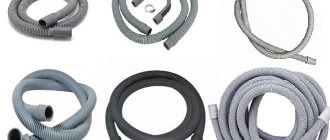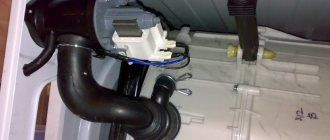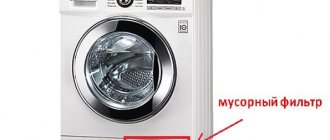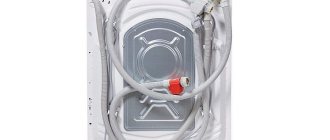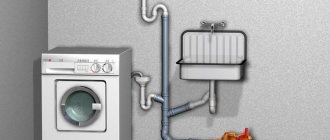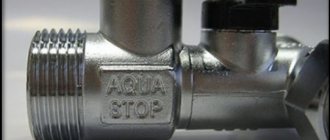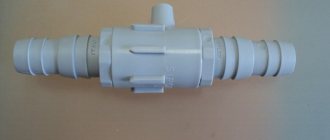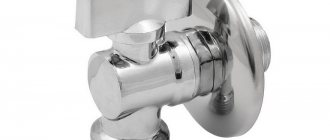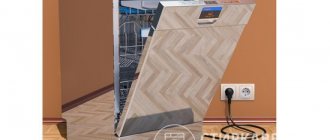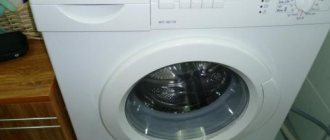When purchasing a washing machine, it is important to choose the right installation location. The ideal location implies unhindered access to sewerage, water and electricity. However, sometimes a situation arises when the unit cannot be installed near all communications. This leads to the need to lengthen the drain hose of the washing machine. How to do this correctly so as not to disrupt the operation of the equipment?
In order to solve the problem of a short drain hose in a washing machine, you need to lengthen it or install a new one of a suitable length
Required tools and parts
Before starting the process, purchase the necessary parts and prepare the tools. First of all, you will need a piece of rubber hose. Before purchasing, determine how long the part is required. To do this, use a tape measure to measure the distance from the washing machine to the entrance to the sewer. Be sure to allow an allowance of a couple of centimeters, keeping in mind that the hose should not be under tension. It’s better to buy a large part - you can always cut off the excess.
Washing machine repair specialists do not recommend using a hose longer than 3.5 m. The power of the drain pump is usually not designed for a greater distance to the sewer. If the hose is too long, the pump will wear out and consume a lot of electricity. This can lead to malfunction of the entire unit.
When installing the drain hose of an automatic washing machine, it is important to correctly calculate its length, which should be enough to connect to the sewer without tension. However, the hose should not be longer than 3.5 m
To extend the drain hose of the washing machine, you will need two clamps measuring 16 x 27 cm. Also purchase a connector (coupling). This is a small plastic tube that is inserted into the hoses, connecting them to each other.
The diameter of the additional hose at different ends may be the same or differ by a couple of millimeters (for example, 19 and 22 mm). The narrow edge is attached to the drain or drain pump of the washing machine. The wide one attaches to the coupling.
To extend the hose, also prepare a screwdriver. It will be needed to clamp the clamps.
Extending the drain tube: procedure
To correctly lengthen the drain hose of a washing machine, first measure the original length and the distance that remains. It is important to consider where the drain tube will run. Also, the extended hose should not be too tight.
You can lengthen the part if you have:
- a special connector in the form of a plastic tube;
- clamps that allow you to securely fix the elements;
- necessary tools.
Drain hose
The tube can be extended with or without a connector. The procedure is performed as follows:
- Clamps are put on the ends of one and the other hose.
- First, the drain hose coming from the washing machine is inserted into the connector, then the one that was purchased to extend the existing tube.
- Next, fix it with clamps using a screwdriver. It is important to make sure that they are firmly attached.
- As soon as the hose can be extended, the device is connected to the sewer, after which a test wash is started.
Drain hose and adapter
While the washing machine is operating, you need to make sure that it can be used. It is worth paying attention to the connection point when draining the water: is it leaking? Otherwise, you need to better secure the extended hose.
How to extend the drain hose of a washing machine: step-by-step instructions
To extend the washing machine drain hose, follow these steps:
- Prepare all the necessary parts and tools.
- Place clamps on the ends of the hoses to be connected.
- Use a coupling to connect the two hoses.
- Use a screwdriver to tighten the clamps. Do not overdo it so as not to damage the parts.
- Connect one end of the hose to the washing machine drain valve and the other to the drain.
- Select the shortest program and run the unit idle. Make sure there are no leaks at the hose connection.
To extend the hose, insert a coupling into the ends of the elements to be connected and secure the edges with clamps. Check the reliability of fastening with your hands, and then in operation by starting the washing machine without laundry.
Features of organizing water drainage from a washing machine
Before you begin to disassemble the issue of connecting the washing machine drain, you need to know that water is pumped out of the machine using a pump, and a short drain hose reduces the load during its operation.
It is also very important to correctly position the washing machine drain hose in the drainage area. The lower edge of the hose directed into the sewer pipe must be located at a distance of at least 60 cm from the sewer and no more than 1 meter. Of course, if the hose is connected to a siphon, then the height does not matter.
When organizing the drainage of water, a rather important point should be taken into account: the edge of the hose should not reach the water, as this creates an obstruction to the flow of water. If you do not take into account the considered features, then a problem with the operation of the washing machine may occur. For example, the display may display an error and the operation cycle may be interrupted.
Drain connection methods
You can connect the washing machine drain using one of several options:
- Using a special clamp - fixing the hose on the side of the bathroom or on the edge of the sink;
- Install the drainage hose and connect it to the siphon;
- Lay an additional drainage pipe elbow.
Any of the above methods is quite simple and does not require special knowledge and skills in handling plumbing. You can easily organize any method of drainage yourself.
However, it should be taken into account that the height of the washing machine drain at the highest point should not be higher than 1 m. Only in this case will the pump be able to fully cope with pumping out water.
Features of replacing the drain hose in units of different models
If it is impossible to extend the hose, it must be replaced. To do this, you should know the design features of the unit. Regardless of the model, the hose is connected to the drain pump. Its location differs in different units, and getting to it can sometimes be difficult.
The drain pump in washing machines Ariston, Samsung, Indesit, Ardo, LG is located at the bottom of the device. To access it, tilt or turn the unit over and remove the bottom cover and drain filter. Then unscrew the clamp and disconnect the tube. Install a new hose and perform all manipulations in reverse order.
Units from well-known brands Bosch and Siemens have a complex design. To access the drain pump and disconnect the hose, follow these steps:
- Remove the powder tray.
- Loosen the clamp securing the rubber cuff and remove it.
- Unscrew the bolts that hold the front panel of the washing machine and remove it.
Only after completing all the steps described above will you gain access to the pump and be able to remove the old hose.
When replacing the drain hose in a washing machine, take into account the design features of different models. The instructions for the unit will help you determine the location of the pump.
To access the drain pump in Zanussi and Electrolux washing machines, you need to remove the back wall. To do this, unscrew the screws holding the top cover and remove it. Then unscrew the bolts that secure the back wall. Remove the housing part and set it aside. Loosen the clamps and replace the hose.
In top-loading units, such as those from Beko, the drain pump is located on the side. To access it, you need to remove the side cover.
Extending or replacing the drain hose in a washing machine does not require special knowledge or skill. You can perform all the steps yourself. The main thing is to check the reliability of all fasteners at the end of the process and make sure there are no leaks.
When is it necessary to replace?
It may be necessary
to replace the hose with a new one
- insufficient length of the existing one;
- material wear.
If the integrity of the hose is damaged, it is recommended to replace it completely. Repair with clamps is not advisable due to poor reliability and short service life. For the same reason, it is not recommended to extend the missing length.
A clogged hose is not a serious reason to replace the part . If it is not worn, it should be cleaned and returned to its place. But in cases where, in addition to the blockage, there are cracks and general wear and tear, it is better to replace it in order to prevent a serious leak from occurring.
How to remove and install a new one?
In Samsung washing machines, the drain hose is attached to a pump located inside the machine. To remove it, you must first partially disassemble the machine .
All actions must be performed without the use of force. Having found the place where the hose is attached to the pump, it is better to photograph it. This will help in the future to correctly mount the new part.
Procedure:
if access is convenient from the rear panel, then unscrew the screws and remove the back wall;- if access is more convenient from the bottom, then remove the bottom panel (if there is one);
- For ease of use, the washing machine can be carefully placed on its side, with a rag underneath so as not to scratch the body;
- Loosen the clamp at the hose entry point so that it can be removed;
- get out the old hose;
- install a new one in the same place;
- fasten the clamp, checking the photograph taken earlier;
- reassemble the washing machine in the reverse order, installing and securing all panels, as well as the hose itself on the machine body;
- Connect the free end of the hose to the sewer.
After completion of work, a test wash should be carried out.
An alternative option is to gain access to the connection to the pump by tilting the washing machine and resting it against the wall. With this method, it is necessary to control the stability of the machine’s location.
Calling a master: what do you need to know?
To replace the drain hose, you can call a technician from a company that repairs household appliances . It is not difficult to find such a company on the Internet; it is also recommended to read customer reviews.
When turning to a private person for repairs, you may end up with a weak specialist or even a scammer. Reputable companies monitor their reputation and hire only experienced people.
When placing an order by phone, you need to specify the problem, then the technician can come directly with a new hose and carry out the replacement very quickly. If a new hose is already available, it is worth mentioning this when calling a specialist.
The cost of the work does not include the price of the main part and consumables, if necessary: tips, sealant, etc. In regions, prices may be lower than in the capital.
In a major city:
- hose repair will cost from 1,200 rubles;
- complete replacement work will cost from 1,400 rubles plus the price of a new hose.
The exact cost is determined in each specific case. Upon completion of the work, a company employee tests the operation of the washing machine and issues a guarantee. When replacing a hose, the warranty can be up to two years.
Repairing an old hose makes sense only in the following cases:
| Problem | Solution |
| The connection to the drain pump in the machine itself is broken | The technician will check the connection, tighten the loose fastening or replace the clamp. If the adapter tip is cracked, it is also replaced. The connections are sealed. |
| There is a leak at the sewer connection point | In this case, you can even turn to the help of a plumber, and not a washing machine repairman. |
For washing machines that are under warranty, you should call a technician from the service center, since even partial disassembly of the device violates the integrity of the seals.
Everything about repairing Samsung washing machines is in this section.
Possible problems and ways to solve them
Expert advice will help you effectively deal with the problem:
- A leak is not always a sign of a broken hose. It is necessary to carefully inspect the entire length of the hose to try to find the location of the break. Leakage can also be caused by wear of other parts.
Ignoring even a small leak can lead to big problems, including flooding downstairs neighbors, damage to the floor, and serious damage to the washing machine itself.
If there is a leak, the problem will only get worse, so it needs to be addressed immediately.- Lack of skills in repairing equipment is a reason to seek help from a specialist. Inept actions can cause harm.
- When bringing the washing machine indoors from the cold, you need to wait for several hours. Since the remaining water that was in the car and turned into ice can cause serious damage.
- If the length of the factory hose is not enough, it is recommended not to extend it, but to replace it with a new one of the required size. The connection point will not have the required reliability.
You should not leave a running washing machine unattended, as an emergency situation may arise, such as a leak.
Reasons for installing a new part
The drain hose takes on a colossal load, discharging waste water into the sewer. It is attached directly to the pump, is made of polypropylene and is able to withstand aggressive chemicals and sudden temperature changes. Despite this, it is often susceptible to mechanical stress, blockages and wear. The need to replace the drain hose arises for several reasons.
- Inappropriate length. The hose that comes with the washing machine does not always fit the meter. It is not advisable to supplement the sleeve with other parts. It is better to disconnect and change the short one to the long one.
- Damage. When the hose is frequently squeezed, fractures often occur with subsequent loss of tightness. Cracks are also possible due to careless handling.
- Blockage. It is rare, but it happens that large debris or a thick layer of scale prevents the hose from fully performing its function.
In private homes, users of washing machines may also encounter mice chewing through the hose. In any case, replacement is also necessary. Fortunately, the cost of corrugation is now low, so there is no need to experiment with electrical tape and sealant.
What to do if water is constantly collecting?
If your Samsung machine continuously pumps water into the system, but the drain hose does not remove it, you need to look for the reason in the pressure switch; most likely, the inlet valve has failed. As a rule, this is preceded by certain reasons:
- the membrane weakens;
- the element completely loses its ability to work normally.
When the drain element is cleaned or replaced, but the malfunction is not eliminated, the device is diagnosed using special equipment.
Preparation for the process
Depending on the model, Samsung washing machines may have different fastenings and the location of the entrance to the drain hose. Despite the nuances of the design, all machines require preliminary preparation before carrying out the main work.
To do this you need:
- Unplug the machine.
- Shut off the water supply to the device.
- Check that there are no things in the drum.
- Drain the remaining water through the bottom filter. To do this, open the lid located on the front panel below and drain the water through the emergency hose into a jar or onto a rag.
- Disconnect the outer end of the old hose from the sewer.
- The washing machine must be pulled out so that you have free access to the rear wall.
- To gain access to the internal structure of the machine, unscrew the screws on the back wall of the machine.
- Slide the top panel back so that it can be removed without effort.
With the panel removed, you need to find where to attach the drain part. And only after that proceed to the main stages - dismantling and installing the hose.
